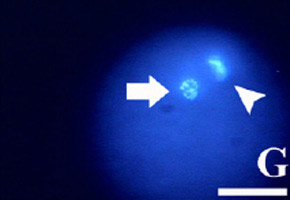

Experiments performed on bovine subjects lead Brazilian researchers to propose a biotech tool for recovering ovule development in infertile women
Experiments performed on bovine subjects lead Brazilian researchers to propose a biotech tool for recovering ovule development in infertile women
Experiments performed on bovine subjects lead Brazilian researchers to propose a biotech tool for recovering ovule development in infertile women

Experiments performed on bovine subjects lead Brazilian researchers to propose a biotech tool for recovering ovule development in infertile women
By Fábio de Castro
Agência FAPESP – A group of Brazilian researchers confirmed the efficiency of a new biotechnological tool for recuperating the development of ovules in infertile women. The study, performed on bovine subjects, was the cover story for the February edition of Reproductive Biomedicine magazine.
The study was coordinated by Flávio Meirelles, professor at the Universidade de São Paulo’s College of Zootechny and Food Engineering (FZEA) in Pirassununga. It was funded through FAPESP’s Regular Research Assistance Program.
Aside from Meirelles and the study’s first author, Marcos Chiaratti, a post-doctoral student at FZEA-USP, researchers from the College of Agrarian and Veterinary Sciences at the Universidade Estadual Paulista (Unesp) in Jaboticabal (SP) Embrapa Pecuária Sudeste in São Carlos (SP) and the University of Montreal’s College of Veterinary Medicine all took part.
According to Chiaratti, the project highlights the huge capacity the technique holds for restoring embryonic development of infertile ovules without consequences for the calves. “In the study we used bovine subjects, but the great similarity in embryonic and fetal development periods means that the technique could also prove important in the human context. The study opens doors for pre-clinical studies aiming toward future application of this tool in humans,” he told Agência FAPESP.
According to Chiaratti, the technique could mean a lot to women that suffer from infertility, especially due to age. “According to the North American Society of Reproductive Medicine, 30% of all women between 35 and 39 years of age are infertile and this percentage increases to 64% among women from 40 to 44 years,” he said.
The technique involves transferring small amounts of cytoplasm from the ovules of younger women to the ovules of infertile women. “There was the hypothesis that this cytoplasm transfer could make up for deficiencies in the ovules of the women with fertility problems,” he pointed out.
Cytoplasm transfer was used at the end of the 1990s in assisted human reproduction clinics in the United States and some other countries, resulting in the births of at least 16 babies. However, in spite of its promising results, it was prohibited by the United States Food and Drug Administration (FDA).
In recent years, many studies have investigated the technique in animal subjects, confirming the previous results in humans. “Our experiment produced healthy animals in 100% of the cases. The fact that it worked in bovines is an excellent indicator that the technique is also safe for humans,” said Chiaratti.
In the experiment, the bovine ovules underwent exposure to ethidium bromide, which has a specific effect on the mitochondria that simulates the ovule problem in women suffering from infertility.
“Afterwards, we used the cytoplasm transfer technique and recovered 100% of ovule yield in terms of embryonic development,” he affirmed.
According to him, the development of techniques to help recover embryonic development is of growing importance, as women are having babies later and later in life. “We know that human fertility decreases gradually over time. This technique specifically benefits individuals who are unsuccessful even with in vitro fertilization. The great step forward that this study represents is that it has shown, through animal subjects that the technique is safe,” Chiaratti affirms.
The article Ooplast-mediated developmental rescue of bovine oocytes exposed to ethidium bromide (doi:10.1016/j.rbmo.2010.10.011), by Marcos Chiaratti, Flávio Meirelles and others can be read by subscribers to Reproductive Biomedicine at www.rbmojournal.com/article/S1472-6483(10)00706-6.
Republish
The Agency FAPESP licenses news via Creative Commons (CC-BY-NC-ND) so that they can be republished free of charge and in a simple way by other digital or printed vehicles. Agência FAPESP must be credited as the source of the content being republished and the name of the reporter (if any) must be attributed. Using the HMTL button below allows compliance with these rules, detailed in Digital Republishing Policy FAPESP.





